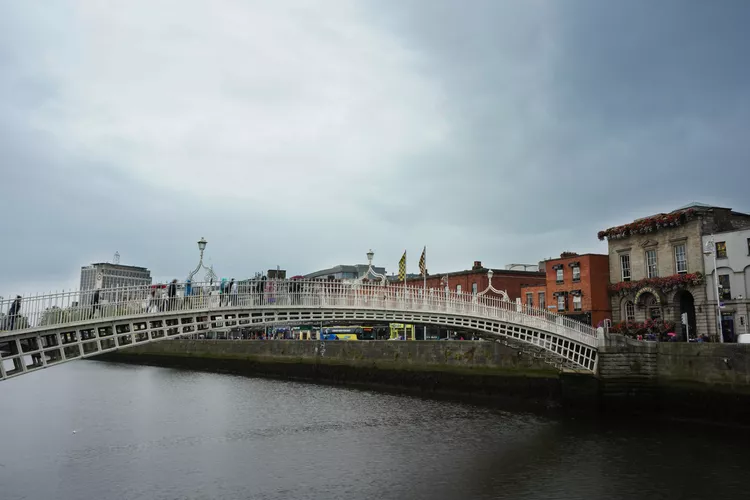The cast-iron beauty has become a symbol of the Irish capital.
Address
Ha’penny Bridge, North City, Dublin, Ireland
Get directions
Visit website
A perfect arch spanning the Liffey River, the Ha’penny Bridge is one of the most recognizable sights in Dublin. It was the city’s first pedestrian bridge and remained the only footbridge in Dublin until the Millennial Bridge opened in 1999.
When it opened in 1816, an average of 450 people crossed its timber planks daily. Today, the number is closer to 30,000 — but they no longer have to pay a ha’penny for the convenience!
History
Before the Ha’penny Bridge was built, anyone needing to get across the Liffey had to travel by boat or risk sharing the road with horse-drawn carriages. Seven different ferries, all operated by a city Alderman named William Walsh, transported passengers over the river at different points along the bank. Eventually, the ferries fell into disrepair, prompting Walsh to build a bridge.
Walsh abandoned his fleet of leaking boats after being granted the right to recoup his lost ferry income by charging a toll for crossing the bridge for the next 100 years. Turnstiles were installed at either end to ensure no one avoided the toll of half a penny. This old halfpenny toll became the bridge’s nickname: Ha’Penny. Since 1922, it has formally been called the Liffey Bridge.
The bridge opened in 1816, and its inauguration was marked with 10 days of free passage before the toll was instituted. At one point, the fee increased to a penny ha’penny (1½ pence), before being eliminated in 1919. Now a symbol of the city, the Ha’penny Bridge was fully restored in 2001.
Architecture
The Ha’penny Bridge is an elliptical arch bridge that stretches 141 feet (43 meters) across the Liffey. It is one of the earliest cast iron bridges of its kind, featuring iron ribs with decorative arches and lampposts. At the time of its construction, Ireland was part of the British Empire, so the bridge was actually manufactured by the Coalbrookdale Company in England and shipped back to Dublin for reassembly.
Visiting
A halfpenny doesn’t go very far these days, but that small toll has long been eliminated, making the Ha’penny Bridge free to visit. Pronounced “Hey-penny,” the bridge never closes and is one of the busiest pedestrian bridges in Dublin. You can visit day or night while exploring the city or stop by on your way to a pub dinner in Temple Bar. However, while it may be tempting to add a love lock to the iron sides, the weight of the locks can damage the historic bridge, so they are no longer permitted.
What to Do Nearby
The Irish capital is compact, and the Ha’penny Bridge is located in the heart of the city, ensuring there is no shortage of activities nearby. On one side of the bridge is O’Connell Street, a bustling thoroughfare lined with pubs and shops. At the center of the street stands The Spire, a stainless-steel monument shaped like a sharpened needle and 390 feet tall, built on the spot where Nelson’s Pillar once stood before being destroyed in a 1966 bombing.
Walk down O’Connell Street and stroll across Ha’penny to find yourself in Temple Bar. The lively pub district is full of revelers day and night, although it is best visited after dark when many bars host live music. For daytime sightseeing, both City Hall and Dublin Castle are just a five-minute walk past Temple Bar.
Just before crossing the bridge, you’ll find a bronze statue of two women sitting down to chat with their shopping bags at their feet on Lower Liffey Street. This 1988 artwork, created by Jakki McKenna as a tribute to city life, is a popular meeting spot and has been given a colorful nickname by Dubliners: “the hags with the bags.”




